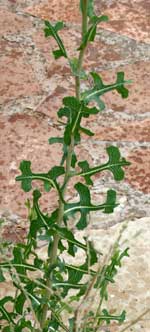 By Steven Horne and Paula Perretty
By Steven Horne and Paula Perretty
Lettuce has been used in salads for thousands of years, but it has a wild cousin that is plucked from yards and gardens everywhere as a weed—wild lettuce. Wild lettuce is native to the western Himalayan region of India and is the plant from which many cultivated lettuces were developed. But don’t go picking this plant for your salad as it is quite bitter, which may explain why the Romans and the Greeks considered the lettuce unlucky and only served it at funerals.
Wild lettuce, also know as prickly lettuce, bitter lettuce and lettuce opium, is an erect leafy plant with leaves similar to those of a dandelion. The plant looks rather unkempt and often grows in cracks in sidewalks, vacant lots and other “waste” places. For these reasons, herbalist Matthew Wood calls wild lettuce the “herbal street person.” He uses it as a remedy for people who have a coldness and hardness about them and are unconcerned about their physical appearance.
Wild lettuce contains a resinous milky sap, which contains a small amount of pain-relieving opiates. When this substance is collected and dried, it is called lactucarium. The main active compounds of lactucarium are called lactupicrin, lactucin and lactucopicrin, and have been found to have analgesic activity equal or greater to that of ibuprofen in mice. Lactucin and lactucopicrin were also found to have sedative activity in measurements of spontaneous movements of the mice.
Gathering lactucarium is a difficult and tedious process. Michael Moore describes how to do it in his book Medicinal Plants of the Desert and Canyon West. He calls the process “the harvesting of the Lactucarium” and says the process “is so boring and tiresome that even I, a little bit fanatic about botanical medicines, have only managed this harvest twice in my two decades of somewhat manic wildcrafting.”
Another way to get the benefits of the mild opiates in wild lettuce is to juice the plant and then dry the juice in fruit leather trays in a dehydrator. According to herbalist Christopher Hobbs, this results in flakes that have a nice analgesic effect.
An even easier way to get the benefits of these mild analgesic and sedative properties of wild lettuce is to make an extract of the fresh, sap-laden plant. Simply cut the stuff, quickly chop it up, pack it tightly into the blender with enough pure vegetable glycerine or EverClear (grain alcohol) to barely cover it and take it for a spin. Strain the mixture, and store it in airtight containers. I’ve made the stuff and it works quite well.
In the 1800s, wild lettuce was considered a substitute for opium and was sometimes called “poor man’s opium.” The Hopi Indians smoked the sap to induce a mild euphoric dream state. Even today, in France, water distilled from wild lettuce is used as a mild sedative.
Why not just use the dried leaf? Well, the dried leaf has value, but it loses most of its pain relieving qualities when dried. The dried leaf, however, still acts as a mild sedative that can help with pain and sleep, especially when combined with other herbs. This is why wild lettuce is included in the herbal aspirin formula, APS II with White Willow Bark.
Wild lettuce can help calm restlessness, anxiety, severe nervous disorders and hyperactivity. It can help with joint and muscle pain and may also ease painful periods.
As a bitter, wild lettuce stimulates the flow of digestive secretions. It is soothing to inflamed mucous membranes, making it effective in easing bronchitis, asthma and dry, irritating coughs by helping to loosen and expel phlegm.
In the eighteenth century, new mothers also used wild lettuce to promote lactation. Because of its safety of use and calming effects, it is a good remedy for children and the elderly. However, wild lettuce is contraindicated for individuals with glaucoma and prostate enlargement.
Selected References:
- The Book of Herbal Wisdom: Using Plants as Medicines
by Matthew Wood.
- American Herbal Products Association's Botanical Safety Handbook
by McGuffin, M. et al.
- Phytochemical and Ethnobotanical Database by Dr. Duke.
- Lactuca scariola by The Himalaya Drug Company.

